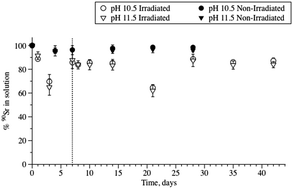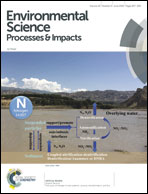Effect of humic acid & bacterial exudates on sorption–desorption interactions of 90Sr with brucite†
Abstract
One of the nuclear fuel storage ponds at Sellafield (United Kingdom) is open to the air, and has contained a significant inventory of corroded magnox fuel and sludge for several decades. As a result, some fission products have also been released into solution. 90Sr is known to constitute a small mass of the radionuclides present in the pond, but due to its solubility and activity, it is at risk of challenging effluent discharge limits. The sludge is predominantly composed of brucite (Mg(OH)2), and organic molecules are known to be present in the pond liquor with occasional algal blooms restricting visibility. Understanding the chemical interactions of these components is important to inform ongoing sludge retrievals and effluent management. Additionally, interactions of radionuclides with organics at high pH will be an important consideration for the evolution of cementitious backfilled disposal sites in the UK. Batch sorption–desorption experiments were performed with brucite, 90Sr and natural organic matter (NOM) (humic acid (HA) and Pseudanabaena catenata cyanobacterial growth supernatant) in both binary and ternary systems at high pH. Ionic strength, pH and order of addition of components were varied. 90Sr was shown not to interact strongly with the bulk brucite surface in binary systems under pH conditions relevant to the pond. HA in both binary and ternary systems demonstrated a strong affinity for the brucite surface. Ternary systems containing HA demonstrated enhanced sorption of 90Sr at pH 11.5 and vice versa, likely via formation of strontium–humate complexes regardless of the order of addition of components. The distribution coefficients show HA sorption to be reversible at all pH values studied, and it appeared to control 90Sr behaviour at pH 11.5. Ternary systems containing cyanobacterial supernatant demonstrated a difference in 90Sr behaviour when the culture had been subjected to irradiation in the first stages of its growth.



 Please wait while we load your content...
Please wait while we load your content...